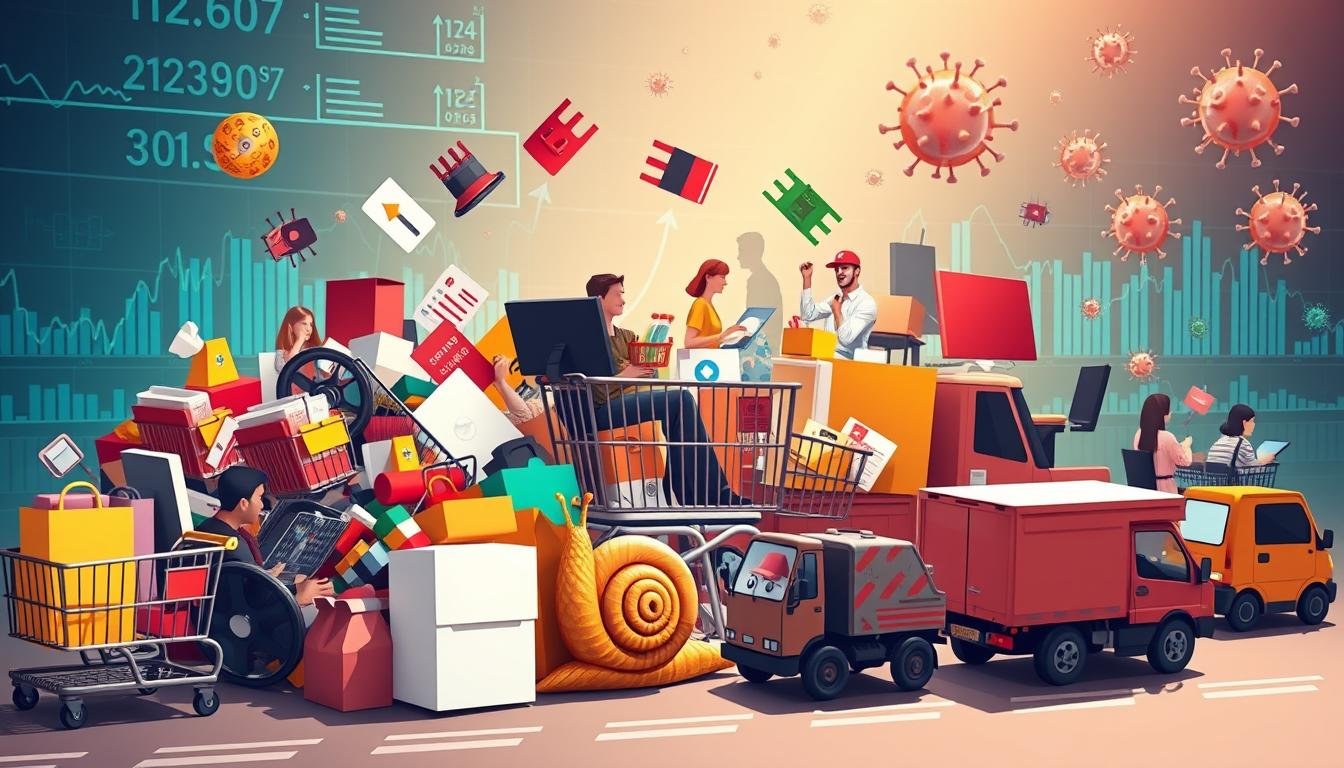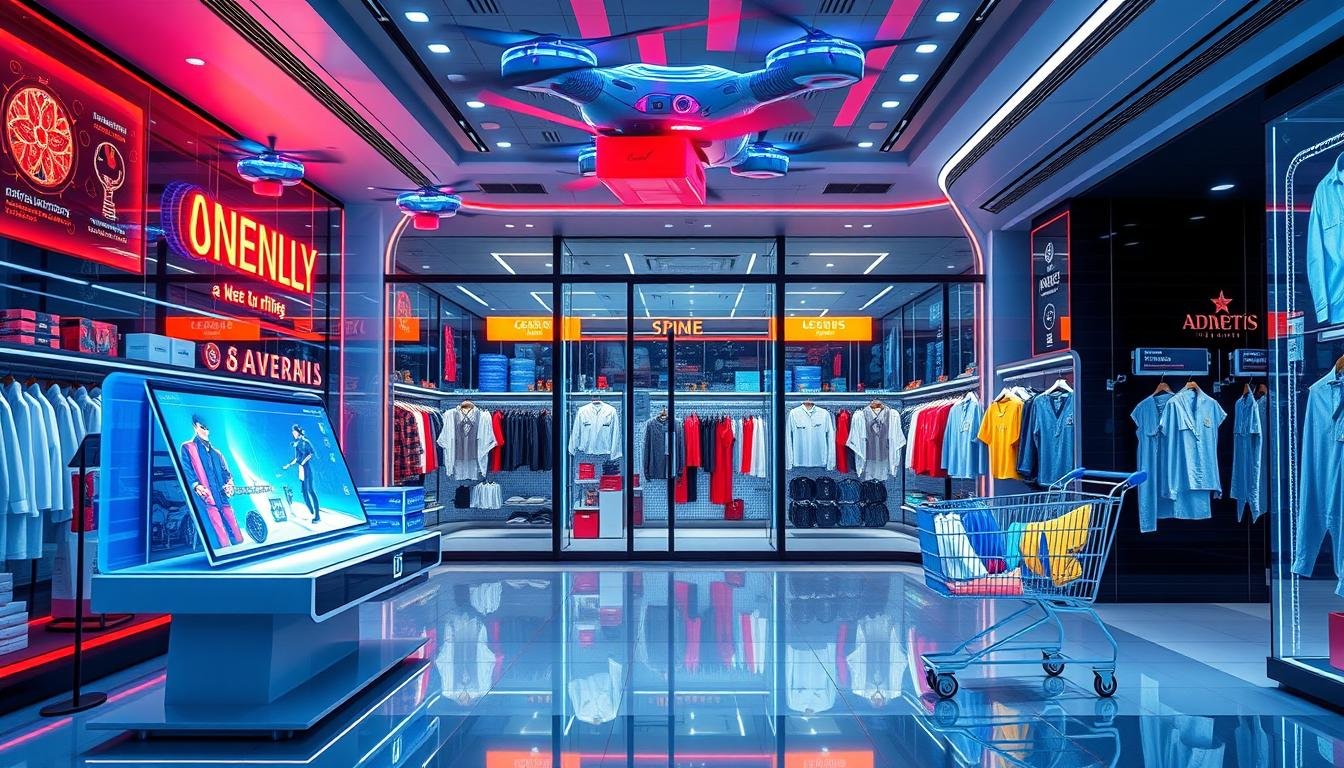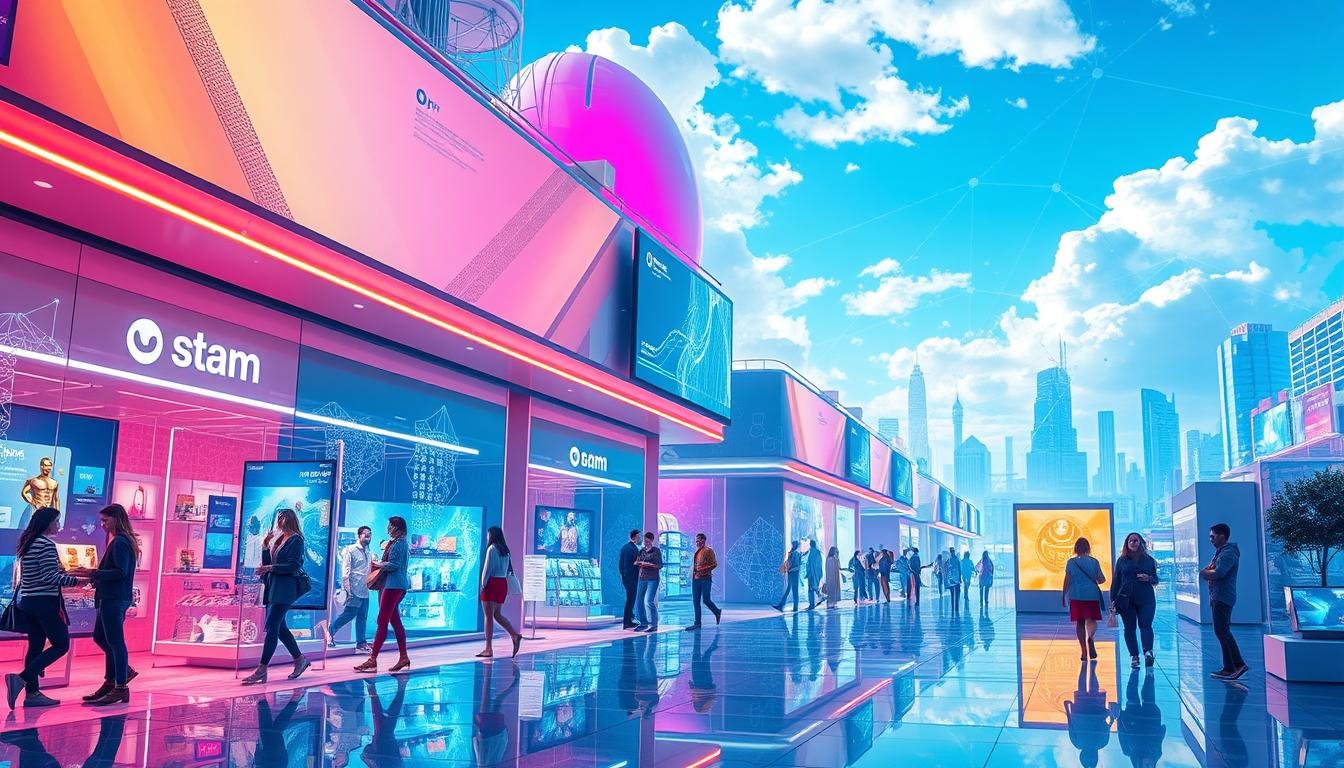The Future of Online Retail: Analyzing Growth Forecasts

Ever thought about the future of online shopping? E-commerce is changing the retail world fast. In 2023, U.S. online shopping made up 22.0% of all retail sales. This growth has been steady for over 20 years.
This article looks at online shopping growth forecasts. We’ll explore new trends in ecommerce and what they mean for businesses and shoppers. I’ll share data-driven insights to help you understand where online shopping is going.
We’ll discuss what’s driving growth, look at online shopping trends by region, and see how new tech is changing things. Let’s explore the digital retail revolution together. Find out how to stay on top in this fast-changing market.
Key Takeaways
- U.S. ecommerce sales grew by 7.6% in 2023, reaching approximately $1.119 trillion.
- The ecommerce segment accounted for nearly half of the total retail growth in the U.S. in 2023.
- North America’s ecommerce market is projected to grow at a CAGR of 16.9% from 2024 to 2030.
- Emerging markets like the Philippines and India are expected to see over 20% year-over-year growth.
- Technological innovations, including voice commerce and mobile payments, are driving shifts in consumer behavior.
Introduction to Online Retail Growth
The online retail world is growing fast, showing big growth in ecommerce. Digital shopping is now a big part of our lives. Knowing about B2C, B2B, and C2C models is key.
In 2023, online sales made up over 19% of all retail sales worldwide. Experts think this trend will keep going. This means a bright future for online shopping, making forecasts very important for businesses and investors.
Understanding the Landscape of E-Commerce
E-commerce covers many areas and sales methods. More people are choosing to shop online, leading to good news for the retail industry. For 2024, US retail sales are expected to hit $7.450 trillion, up 2.8% from last year.
This shows digital commerce is playing a bigger role, even though physical stores are more common. They make up 83.7% of all retail sales.
Importance of Growth Forecasts
Growth forecasts are key for understanding what customers want and how markets work. They help businesses plan and make sure they offer what customers need. For example, ecommerce sales are expected to grow 8.2%, much faster than physical retail’s 1.8%.
Looking at these trends is vital for anyone in retail. Knowing about prices, what customers want, and holiday spending helps businesses stay ahead. As the market changes, retailers can find new ways to reach more customers.
If you’re looking for the best kitchen appliances, check out the top blenders for 2024 here.
Factors Driving Online Retail Growth
Online retail is growing fast, thanks to technology, changing consumer habits, and mobile commerce. These factors shape the future of online shopping. Let’s dive into how they impact ecommerce trends and the retail forecast for the next few years.
Technological Innovations in Retail
Technology is key to online retail’s growth. Tools like artificial intelligence and automated customer service improve shopping. Data analytics help tailor products and manage supply chains.
More people using smart devices boosts ecommerce. By 2024, online retail is expected to grow 8.2%, outpacing physical stores by 6.4%.
Changes in Consumer Behavior
Consumer preferences are driving the online shopping boom. People want convenience and efficiency in their shopping. Online shopping offers flexibility and ease, making it a top choice.
By 2027, 23.6% of global retail sales will be online. This shows how changing behaviors are changing how we shop.
The Role of Mobile Commerce
Mobile commerce is a big player in online retail growth. Smartphones and tablets let people shop anytime, anywhere. This boosts impulse buys and shapes the retail forecast.
By 2023, more online sales happen on mobile devices. Businesses are focusing on mobile optimization for better user experiences.
| Year | Global E-Commerce Sales (Trillions) | Percentage of Total Retail Sales |
|---|---|---|
| 2020 | $4.28 | 14.1% |
| 2021 | $6.54 | 15% |
| 2024 (Projected) | $6.38 | Approximately 25% |
| 2027 (Projected) | $8+ Trillion | Nearly 25% |
Regional Analysis of Online Retail Trends
It’s key to know how online shopping varies by region. Each area has its own way of growing in e-commerce. This is due to different market conditions, what people like to buy, and new tech.
By studying these trends, we can make better plans for online shopping. This helps us use forecasts and predictions to our advantage.
E-Commerce Growth in North America
In North America, online shopping is growing fast. It’s expected to hit $7.45 trillion by 2024. This makes North America very important in the world of online shopping.
More people are using their phones to shop online. This change shows how big online shopping has become. With more internet and phones, people can shop easily online.
Emerging Markets: A Focus on Asia
Asia is a big player in online shopping, with countries like India and China leading the way. The growth here is huge, thanks to the economy and more money for the middle class.
New trends like quick delivery are changing how people shop online. This means stores have to keep up with fast delivery demands. The growth rate in Asia shows its big role in online shopping worldwide.
European Market Insights
The European online shopping scene is diverse. It has a steady growth, thanks to good infrastructure and online shopping strategies. Stores are now using subscription services to make shopping easier for customers.
Knowing what people in different European countries like helps stores meet their needs. This way, stores can better match what customers want and follow online shopping trends.
The Impact of Social Media on Retail
Social media has changed the retail world a lot. It’s now how people talk to brands and buy things. More platforms are adding shopping features, making social commerce big in ecommerce growth. Influencer marketing and social media are changing how we shop in new ways.
Influencer Marketing Trends
Influencer marketing is growing and changing how we see brands. Young people, aged 18 to 34, are buying things on Instagram and TikTok. For example, 35% of them bought on Instagram, and 31% on TikTok. This shows how important young people are in making sales through influencers.
Social Commerce: A New Revenue Stream
Social commerce is becoming a big way for brands to make money. It’s expected to be almost 7% of all ecommerce sales by 2025. TikTok is getting a lot of new shoppers, over 11.6 million in 2024. This shows people are okay with buying things on social media.
| Platform | Projected US Social Buyers (2024) | Percentage of US Population |
|---|---|---|
| 64.6 million | 20.5% | |
| 46.8 million | 15.0% | |
| TikTok | 35.8 million | 11.5% |
| Total Social Buyers | 110.4 million | 42% of Internet Users |
By using influencer marketing and social commerce, retailers can sell more and keep customers loyal. This change is full of chances for brands that want to be creative and reach out to their audience on social media.
Sustainability in Online Retail
The world of ecommerce trends is changing fast, with a big focus on being green. People today care more about the planet, making stores change their ways. They’re now using eco-friendly materials and cutting down on packaging waste.
These moves show stores care about our planet. They also win over customers who value the environment.
Eco-Friendly Practices for Retailers
Looking into eco-friendly actions, I see some big steps:
- Sustainable Sourcing: Stores are choosing suppliers who are kind to the earth.
- Reduced Packaging Waste: Companies are making their packaging smaller and more recyclable.
- Recycling Programs: Programs like Target’s car seat trade-in have recycled over 3 million seats, showing a big commitment to less waste.
- Secondhand Marketplaces: Walmart’s Resold marketplace, with over 5 million secondhand items, shows a move towards a circular economy.
Consumer Preferences Toward Sustainability
What people want is changing retail towards being greener. A big chunk of digital shoppers prefer brands that are real and care about values. It’s interesting that 80% of shoppers are ready to spend more on items made in a green way.
This shows that caring for the planet is more than just a trend. It’s a key part of what people look for when they shop. They check how brands make things and how they package it, with 40% and 38% looking at these areas, respectively.
With social media, people can easily find and support brands that are green. This direct link can shape their views on a brand’s eco-friendliness. As retail keeps evolving, making sustainability a key part of business plans is vital for success. By going green, stores can stand out and help our planet at the same time. For more on how these trends affect our daily choices, see this article on quiet blenders.
Challenges Faced by Online Retailers
Online retail faces many challenges. These issues affect their operations and growth. Supply chain disruptions and intense competition are major concerns.
Supply Chain Disruptions
Global events can disrupt supply chains. This leads to inventory shortages and delayed shipments. Nearly 30% of retail executives plan to invest in modernizing their supply chains.
This investment is key for better efficiency. Despite 80% of shopping happening in physical stores, the need for a strong supply chain is growing. Shifting consumer expectations and logistical challenges make this more important than ever.
Intense Competition in the Marketplace
The e-commerce space is very competitive. Providing great customer experiences is essential. With global e-commerce conversion rates below 3%, retailers must innovate to stand out.
Companies that offer unique products can focus on niche markets. This helps build brand loyalty and recognition in a crowded market.

| Challenges in Online Retail | Impact | Strategies to Overcome |
|---|---|---|
| Supply Chain Disruptions | Inventory shortages, delayed shipments | Investments in technology and logistics improvement |
| Intense Competition | Saturated market, low conversion rates | Differentiation through unique offerings and enhanced customer experiences |
| High Customer Acquisition Costs | Decreased profitability, reduced visibility | Effective SEO strategies and reputation management |
| Consumer Expectations | Need for engaging online experiences | Focus on customer retention and satisfaction |
Online retailers must stay alert and think creatively. Adapting to changes is key to success and survival in e-commerce.
The Role of Data Analytics in Retail Growth
In today’s competitive retail world, using data analytics is key. It helps understand what customers want and manage stock better. Retailers who use these insights can improve shopping experiences and work more efficiently. The trends in retail analytics and online growth are very promising.
Utilizing Data for Customer Insights
Retailers are using data to make shopping more personal. A big 64% of consumers like it when brands know their preferences. Companies that use advanced analytics grow 12% faster than others.
Those who study customer data see a 20% boost in promo success. This shows how important data is for good marketing.
Predictive Analytics in Inventory Management
Predictive analytics changes how stores manage stock. It helps predict demand, cutting stockout by 50%. For example, using predictive analytics, manufacturers can turn stock over 30% faster.
Walmart has seen sales go up by analyzing past data and other factors. This helps them forecast demand better.
Data analytics does more than just help with stock. It also boosts sales. Stores that use data to set prices see a 5% to 10% sales jump. Looking at past purchases can increase basket size by 15%.
Email marketing that uses data can get click-through rates over 20%. This is way above average.
| Statistic | Impact |
|---|---|
| 75% of organizations using retail analytics | Report improved decision-making capabilities |
| 70% of FMCG businesses analyzing customer data | Optimize promotions for a 20% increase in effectiveness |
| Zara’s use of big data | Reduced inventory costs by 15% |
| Macy’s dynamic pricing strategy | Increased online sales significantly |
| Amazon’s personalized recommendations | Drive substantial revenue growth |
Data analytics helps understand customers and improve stock management. Retailers who invest in data tools are set for big gains and growth in the digital market.
Future Technologies Shaping Online Retail
New technologies are changing online shopping in big ways. Augmented reality (AR) and artificial intelligence (AI) are making shopping better and easier. These tools will help shape the future of online retail.
The Rise of Augmented Reality
AR is becoming a big deal in online shopping. It’s expected that over 100 million people in the U.S. will use AR by 2025. This tech lets people see how products look in their own space before buying.
Retailers using AR create fun, interactive experiences. This helps them connect better with their customers.
AI and Chatbots in Customer Experience
AI and chatbots are making customer service better. They help understand what each customer likes. This is key as more people want personalized shopping experiences.
As the subscription economy grows to $1.5 trillion by 2025, AI will help businesses stay ahead. It’s all about keeping up with changing trends.
Also, over 70% of shoppers are willing to pay more for eco-friendly products. New tech will help meet these demands, boosting online retail even more.

| Technology | Impact on Retail | Projected Growth by 2027 |
|---|---|---|
| Augmented Reality (AR) | Enhances shopping experience through product visualization. | Exceeding 100 million users in the US. |
| Artificial Intelligence (AI) | Improves customer service and personalization. | Significant influence on the subscription economy. |
| Chatbots | Facilitates efficient customer interactions. | Increased loyalty through tailored experiences. |
| Mobile Commerce | Grows to 62% of all ecommerce by 2027. | Continued rise in mobile shopping. |
Omnichannel Strategies for Retail Success
In today’s retail world, businesses need new ways to succeed. Omnichannel strategies help merge online and offline shopping into one journey. This approach makes shopping smoother, boosting customer happiness and online success.
Integrating Online and Offline Experiences
For online success, blending online and offline shopping is key. Omnichannel stores keep 90% more customers than single-channel ones, says CapitalOne Shopping Research. The focus should be on:
- Unified Customer Experience: Keep the shopping vibe consistent across all channels.
- Cross-Channel Promotions: Use both online and in-store deals to get customers involved.
- Integrated Loyalty Programs: Reward customers with incentives that work everywhere.
The Importance of Customer Engagement
Keeping customers engaged is essential for omnichannel success. Stores using three or more channels see a 250% boost in engagement. Key points include:
- Data-Driven Insights: Use customer data to shape strategies and improve experiences.
- Proactive Communication: Talk to customers through many channels, solving their issues.
- Enhanced Customer Experience: Ensure shopping is easy and meets today’s standards.
Though setting up omnichannel strategies can be tough, the benefits are huge. They open up new revenue paths, lower risks, and keep up with what customers want. With a $1.5 trillion omni opportunity in the U.S., it’s time for retailers to dive in.
| Benefit | Impact on Retail |
|---|---|
| Customer Retention | 90% retention in omnichannel vs. single-channel |
| Engagement | 250% increase with three or more channels |
| Loyalty Programs | Stronger connections lead to repeat purchases |
| Conversion Rates | Higher rates by removing friction points |
| Revenue Diversification | Stability against disruptions in one channel |
Using advanced CRM and ERP systems can also help. Knowing each channel well helps tailor products, prices, and marketing.
Predictions for the Future of Online Retail Growth
The world of online shopping is changing fast, bringing new chances and challenges. As eCommerce grows, knowing the trends and key numbers is key. We’ll look at important digital shopping predictions and what to focus on in the future.
Forecasts for 2024 and Beyond
By 2024, global eCommerce sales are set to hit over $6 trillion, making up 24% of all online shopping. By 2027, this number will go over $7.9 trillion. With more people shopping online, reaching 2.71 billion, the trend is clear.
In the U.S., online sales will jump from $1.2 trillion in 2024 to $2 trillion by 2028. This shows a big growth in digital shopping habits.
Key Metrics to Watch
Keeping an eye on important numbers is essential in this changing retail world. Key metrics include:
- User Engagement: It’s key, as it affects how many people buy and stay loyal.
- Conversion Rates: Desktops have a 3% rate, while smartphones have a 2% rate.
- Market Adaptation: Over 80% of retailers use or plan to use AI chatbots, improving customer service.
- Mobile Commerce Trends: Mobile phones drive 77% of global retail traffic. Mobile sales are expected to hit 3.4 billion by 2027.
- Consumer Trust Factors: Almost 62% of shoppers trust online reviews on a site, showing how important trust is.

The future of online shopping looks exciting, with new tech and changing tastes leading the way. Businesses must adapt to these trends to succeed in the ever-changing market.
Conclusion: Embracing Change in Online Retail
In the fast-changing world of online shopping, being flexible is key. As e-commerce grows, retailers must keep up with what customers want and new tech. With e-commerce expected to grow by 56% in the next five years, being quick to adapt is vital.
Ignoring these changes can hold you back in a field that’s always moving. It’s important to stay ahead of the game.
Staying Adaptable in a Fast-Paced Market
Successful online stores are those that welcome change and keep improving their online sales plans. The rise of third-party sales and direct-to-consumer models shows the need to use many sales channels. With social commerce set to double by 2028, using platforms like TikTok is key.
Creating products that fit what customers want and making shopping personal are key to keeping customers loyal. These are essential parts of any growth plan.
Final Thoughts on Growth Strategies
The future of online shopping calls for a strong focus on innovation and being quick to respond. With global online sales expected to hit $6.4 trillion by 2024, there’s a lot of room for growth. By focusing on customer engagement and being green, retailers can overcome challenges and seize new chances.
I think the brands that stay alert and flexible will do well in this changing online world.